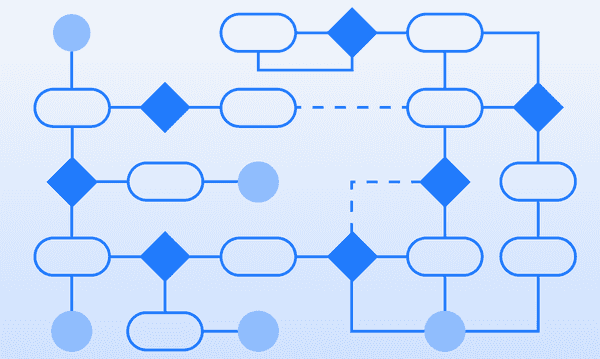How to Create an Effective Sales Workflow
A strong workflow can be a sales team’s most valuable asset. In this blog post, we will share some valuable tips to help you build an effective sales workflow that streamlines tasks, improves the customer journey, and ultimately improves the productivity of your sales team.
7 min read

Tatiana Ogurtsovskaia
May 06, 2021

A sales workflow is a set of steps that your sales team takes to attract, acquire and convert prospects to customers. The objective of a sales workflow is to close deals, and it’s a bonus if you can get them over the line quickly. Building a workflow is vital to your company’s success. It can ensure a high-quality customer journey, influence your team by helping them be more efficient and consistent, and ultimately impact your bottom line.
In order to create an effective sales workflow, you first need to analyze your current sales cycle and see where the opportunities to streamline may exist. The best way to analyze your sales cycle is to review key sales metrics, metrics such as the average cycle length, the number of steps involved, buyer personas, and drop-off points. The data will be crucial for understanding where the opportunities for improvement lie, enabling you to implement actionable steps to help you close more deals faster. Besides looking at metrics, you should consult with your sales team; your sales reps will know your customers best and, therefore, be able to provide insights into customer behavior and identify additional challenges that they may have. By better understanding your customers, you can deliver a better workflow that meets their expectations.
If your sales team is currently operating without a sales workflow, or you find that your current process isn’t effective, then you have come to the right place. We have created a start-to-finish guide on how to build a solid sales workflow that will improve the customer experience, optimize productivity and give you a competitive edge.
What is a Workflow?
Before we can cover the details of mapping out your sales process, we will do a deep dive into what a workflow is. A workflow in sales refers to a sequence of tasks that the sales team takes to move a prospect from a lead to a customer. Also known as a sales process, a strong workflow provides a framework that guides the sales representatives through each step, helping them to optimize productivity.
What is Workflow Automation?
In sales, time is money; the last thing you need is your sales team wasting their valuable time on tedious tasks such as entering manual data. Luckily, there is workflow automation software that can automate your processes and save you time, money, and resources on mundane tasks. An effective sales workflow will use workflow automation tools such as a Customer Relationship Management system (CRM) to capture customer information, automate nurturing emails, book customer meetings, set up reminders, and qualify leads. CRM workflow automation provides a solution that enables sales teams to streamline processes and quickly adapt to changing customer needs.
The Five Stages of a Sales Workflow
Implementing these five stages in your sales workflow will help to improve efficiency and ultimately drive better results.
Prospecting
Prospecting or generating leads is the process of identifying and sourcing new potential customers. Prospects are people who have expressed interest in the product or service you are offering or those who, based on their demographic, interests, or industry, maybe potentially interested. One of the key elements of effective prospecting is to have first created your ideal buyer persona. Your buyer persona identifies the client who is likely to be interested in your product or service. Part of identifying your buyer persona is understanding their needs and challenges; knowing what makes them tick will help you tailor your marketing material and increase your odds of attracting high-quality leads.
Prospecting can be done via online research, hosting a webinar, connecting on social media platforms, attending networking events, buying online lead lists, and using inbound marketing tactics such as blogs, podcasts, and ebooks. Businesses can also gain access to potential buyers through social media ads such as LinkedIn and Facebook lead ads, physical industry events, or referrals by current clients.
Qualifying
The next step in the sales process is connecting with the potential leads, conducting research, and gathering first-hand information to determine if they will qualify as high-quality leads and, therefore, move to the next stage of the lead workflow. Not all leads are created equal, and it is vital that sales teams prioritize and focus their attention on the high-quality leads with the biggest potential to convert. There are four key identifiers that will tell you if a lead is high quality or not; budget, authority, need, and timeline. By finding out if your lead ticks these boxes, you are able to determine if your prospect wants what you are selling, has the power to make the decision, and is ready to buy in the near future.
Another part of the qualifying process is identifying your customer’s pain points, challenges, and any potential business goals. You can find these out by asking what their role is, what they do on a daily basis, what they find challenging, what other solutions they are evaluating, and what would help them do their job better. The answers to these questions will be instrumental in personalizing your offer in the next step of the sales process.
Presenting
Once you have qualified the prospect and gathered information about their challenges, needs, and goals, you are ready to pitch. A pitch is where your salesperson runs a presentation, demonstration, or detailed overview of your product or service. The pitch will be a key aspect of the workflow for converting the customer; it is the perfect opportunity to demonstrate your solution’s impact.
Each presentation should be personalized, using the information you have gathered in the qualification stage to make a compelling case about how your product or service will fill the prospect’s needs. Research and preparation will play a key role in the success of your pitch, be sure to prepare answers to anticipated questions; you are better to be over-prepared than underprepared. If you know your customer is technical and that is not your area of expertise, consider getting one of your engineers or coworkers in the meeting to answer those specific questions.
Handle Objections
It is rare for a prospect to have no objections. Even if your product is the right solution at the right time, the prospect may have some hesitations, and your sales team should be ready to handle them. While ideally, the qualifying stage of your sales process should have identified any objections that your prospect may have, such as budget or timing, you should always be prepared to rebuttal any outstanding questions they have. Usually, you can handle objections by either redemonstrating the value of your product or finding a way to tailor your solution to their needs.
The Close
Closing is the dotting of the i’s and crossing of the t’s. It is where the prospect becomes a customer by agreeing to the quote, proposal, or negotiation terms. However, just because the deal has been finalized and the product has been delivered, the sales process is not over. A salesperson should ensure that they nurture the relationship by providing the proper post-sale support as well as explore any opportunities to increase the business relationship, for example, upselling, cross-selling, and asking for referrals.
Conclusion
An efficient sales process is never set in stone. It should be revised and adapted regularly, ensuring that it reflects the current market, your customer’s needs, your team’s capabilities, and your company’s overall goals. Check in with your sales reps regularly to monitor sales activities and track metrics to evaluate how your sales workflow is going and make any tweaks you believe necessary.
One way to make your sales process easier is finally taking advantage of sales automation. Sales workflow and automation go hand in hand; the less time your sales team spends doing mundane administrative tasks, the more time they can focus on your potential clients, building relationships, and closing more deals. Whether you are a startup, SMB, or enterprise, the right automation tools can help you to optimize productivity, so you have more time to focus on building relationships and closing deals.


